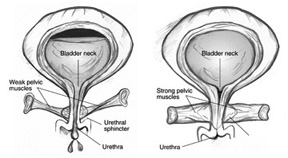What are Kegel exercises?
Kegel exercises, also called Kegels or pelvic floor muscle training, are exercises for your pelvic floor muscles to help prevent or reduce stress urinary incontinence. Your pelvic floor muscles support your uterus, bladder, small intestine, and rectum.
Four in 10 women improved their symptoms after trying Kegels. Kegels can be done daily and may be especially helpful during pregnancy. They can help prevent the weakening of pelvic floor muscles, which often happens during pregnancy and childbirth. Your pelvic floor muscles may also weaken with age and less physical activity.
Some women have urinary symptoms because the pelvic floor muscles are always tightened. In this situation, Kegel exercises will not help your urinary symptoms and may cause more problems. Talk to your doctor or nurse about your urinary symptoms before doing Kegel exercises.
- The bladder on the left has weak pelvic muscles that fail to keep the urethra closed, so urine escapes. The bladder neck, weak pelvic
- The bladder on the right has strong pelvic muscles that keep the urethra closed, so no urine can escape.
How do I do Kegel exercises?
To do Kegels:
- Lie down. It may be easier to learn how to do Kegels correctly while lying down. You don’t have to lie down once you learn to do Kegels correctly.
- Squeeze the muscles in your genital area as if you were trying to stop the flow of urine or passing gas. Try not to squeeze the muscles in your belly or legs at the same time. Try to squeeze only the pelvic muscles. Be extra careful not to tighten your stomach, legs, or buttocks (because then you will not be using your pelvic floor muscles).
- Relax. Squeeze the muscles again and hold for 3 seconds. Then relax for 3 seconds. Work up to 3 sets of 10 each day.
- Practice Kegels anywhere. When your muscles get stronger, try doing Kegels while sitting or standing. You can do these exercises at any time, such as while sitting at your desk or in the car, waiting in line, or doing the dishes. Don’t do Kegel exercises at the same time you are urinating. This can weaken your pelvic floor muscles over time.
If you are uncomfortable or uncertain about doing Kegel exercises on your own, a doctor or nurse can also teach you how to do Kegels. A pelvic floor physical therapist or other specialist may also be available in your area to help teach you how to strengthen these muscles.
How soon after starting Kegel exercises will urinary incontinence get better?
It may take 4 to 6 weeks before you notice any improvement in your symptoms.
Kegel exercises work differently for each person. Your symptoms may go away totally, you may notice an improvement in your symptoms but still have some leakage, or you may not see any improvement at all. But even if your symptoms don’t get better, Kegel exercises can help prevent your incontinence from getting worse.You may need to continue doing Kegel exercises for the rest of your life. Even if your symptoms improve, urinary incontinence can come back if you stop doing the exercises.
Other Tips
- The first step is to find the right muscles. One way to find them is to imagine holding in urine or tighten the area around the opening of the vagina.
- Try not to squeeze other muscles at the same time. Be careful not to tighten your stomach, legs, or buttocks. Squeezing the wrong muscles can put more pressure on your bladder control muscles. Just squeeze the pelvic muscles and keep breathing.
- Repeat, but don't overdo it. At first, find a quiet spot to practice-your bathroom or bedroom-so you can concentrate. Pull in the pelvic muscles and hold for a count of three. Then relax for a count of three. Work up to three sets of 10 repeats.
- Be patient. Don't give up. It takes just 5 minutes a day.
Source: Office on Women's Health
Last updated : 1/3/2023